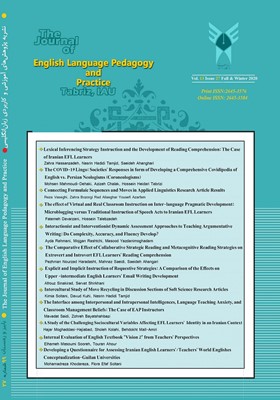بیان شک و اطمینان در مقالات تحقیقی: تحلیل مقابله ای نوشته های انگلیسی زبانان و فارسی زبانان در حوزه زبانشناسی کاربردی و مهندسی
Subject Areas : آموزش زبان انگلیسی
1 - University of Tabriz
2 - University of Tabriz
Keywords: مقالات تحقیقی, ابزارهای بیان شک و اطمینان, شک و اطمینان,
Abstract :
بیان شک واطمینان در مقالات تحقیقی از اهمیت خاصی برخوردار است. به این دلیل که در مقالات نویسندگان باید نظر خود را از واقعیت متمایز کنند و دلایل و توضیحات خود را به شیوه ای قانع کننده و قابل قبول بیان کنند. علی رغم اهمیت این موضوع، تحقیقات زیادی در مورد چگونگی استفاده از ابزارهای بیان شک (Hedges) و اطمینان ((Boosters در رشته های مختلف، گونه های مختلف نوشتاری و مقالات نویسندگان غیرانگلیسی زبان صورت نگرفته است. مطاالعه حاضر می کوشد استفاده از این ابزارها را در مقالات تحقیقی در دو رشته ی مهندسی برق و زبانشناسی کاربردی و مقالات نوشته شده توسط انگلیسی زبانان و ایرانیان به زبان انگلیسی در این دو رشته بررسی کند. به این منظور در بیست مقاله تحقیقی این دو رشته توزیع کلی و بلاغی انواع مختلف این ابزارها در چهار قسمت مقالات (چکیده، مقدمه، بحث و بررسی، و نتیجه گیری) به ازای هر 1000 کلمه محاسبه و مورد بررسی قرار گرفت. نتایج نشان داد که توزیع کلی این ابزارها در مقالات زبانشناسی کاربردی بیشتر از مقالات مهندسی برق است. علاوه بر این تفاوت هایی بین نویسندگان انگلیسی زبان و غیر انگلیسی زبان در استفاده از این ابزارها وجود دارد. یافته های این تحقیق می تواند در تدریس نگارش پیشرفته و زبان تخصصی دردانشگاههای کشورمان مورد استفاده قرار گیرد.
Brown, J. D. (1988). Understanding research in second language learning (2nd edition). Cambridge: CambridgeUniversity Press.
Brown, P., & Levinson, S. (1987). Politeness: Some universals in language usage. Cambridge: Cambridge University Press.
Coates, J. (1983). The Semantics of modal auxiliaries. Beckenham: Croom Helm.
Crompton, P. (1997). Hedging in academic writing: Some theoretical problems. English for Specific Purposes, 16(4), 271-287.
Crystal, D. (1995). In search of English: A traveler's guide. ELT Journal, 49(2), 107-121.
Falahati, R. (2006). The use of hedging across different disciplines and rhetorical sections of research articles. [Papers from the 22nd Northwest Linguistics Conference] (www.sfu.ca/gradlings/NWLC-Proceedings.htm).
Holmes, J. (1982). Expressing doubt and certainty in English. RELC Journal, 13(2), 19-28.
Holmes, J. (1984). Modifying illocutionary force. Journal of Pragmatics, 8, 345-365.
Holmes, J. (1988). Doubt and certainty in ESL textbooks. Applied Linguistics, 9(1), 20-44.
Holmes, J. (1990). Hedges and boosters in women's and men's speech. Language and Communication, 10(3), 185-205.
Hyland, K. (1996a). Talking to the academy: Forms of hedging in science research articles. Written Communication, 13(2), 251-281.
Hyland, K. (1996b). Writing without conviction? Hedging in science research articles. Applied Linguistics, 17(4), 433-454.
Hyland, K. (1996c). Nurturing hedges in the ESP curriculum. System, 24(4), 477-490.
Hyland, K. (1998). Boosting, hedging and the negotiation of academic Knowledge. TEXT, 18(3), 349-382.
Hyland, K. (2000). Hedges, boosters and lexical invisibility: Noticing Modifiers in academic texts. Language Awareness, 9 (4), 179-194.
Hyland, K., & Milton, J. (1997). Qualification and certainty in L1 and L2 Students' writing. Journal of Second Language Writing, 6 (2), 183-205.
Lewin, B.A. (2005). Hedging: An exploratory study of authors' and readers' identification of 'toning down' in scientific texts. Journal of English for Academic Purposes, 4, 163-178.
Myers, G. (1989). The pragmatics of politeness in scientific articles. Applied Linguistics, 10 (1), 1-35.
Quirk, R., Greenbaum, S., Leech, G., & Starvik, J. (1985). A comprehensive grammar of English language. London and New York: Longman.
Salager-Meyer, F. (1994). Hedges and textual communicative function in medical English written discourse. English for Specific Purposes, 13 (2), 149-170.
Skelton, J. (1997). The representation of truth in academic medical writing. Applied Linguistics, 18 (2), 121-140.
Stubbs, M. (1986). 'A matter of prolonged fieldwork': Notes towards a model grammar of English. Applied Linguistics, 7 (1), 1-25.
Swales, J. M. (1990). Genre analysis: English in academic and research settings. Cambridge: Cambridge University Press.
Swales, J. M. (2004). Research genres: Exploration and applications. Cambridge: Cambridge University Press.
Thomas, J. (1983). Cross-cultural pragmatic failure. Applied Linguistics, 4(2), 91-112.
Thue Vold, E. (2006). Epistemic modality markers in research articles: a Cross-linguistic and cross-disciplinary study. International Journal of Applied Linguistics, 16 (1), 61-87.
Varttala, T. (2001). Hedging in scientifically oriented discourse: Exploring variation
according to discipline and intended audience. Electronic doctoral dissertation. Acta Electronica Universitatis Tamperensis 138 (http://acta.uta.fi/pdf/951-44-5195-3.pdf).
Vassileva, I. (2001). Commitment and detachment in English and Bulgarian academic writing. English for Specific Purposes, 20, 83-102.
West, G. K. (1980). That-nominal constructions in traditional rhetorical divisions of scientific research papers. TESOL Quarterly, 14, 483-488.


